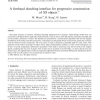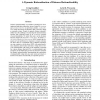92 search results - page 15 / 19 » Intuitive quasi-eigen faces |
ITSSA
2006
13 years 7 months ago
2006
: The software industry is faced with the fast growing complexity of IT infrastructures. This makes manual administration increasingly difficult and appears to be the limiting fact...
CG
2005
Springer
13 years 7 months ago
2005
Springer
This paper presents an intuitive, freehand sketching application for Computer Aided Design (CAD) that can reconstruct a 3D object from a single, flat, freehand sketch. A pen is us...
NN
2002
Springer
13 years 7 months ago
2002
Springer
Recognition-by-components is one of the possible strategies proposed for object recognition by the brain, but little is known about the low-level mechanism by which the parts of o...
CORR
2012
Springer
12 years 3 months ago
2012
Springer
Let G be a directed graph with n vertices and non-negative weights in its directed edges, embedded on a surface of genus g, and let f be an arbitrary face of G. We describe an alg...
AAAI
2012
11 years 9 months ago
2012
Distance rationalizability is an intuitive paradigm for developing and studying voting rules: given a notion of consensus and a distance function on preference profiles, a ration...


